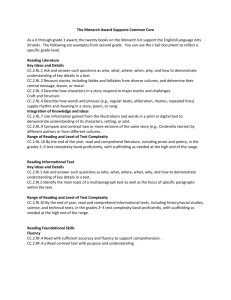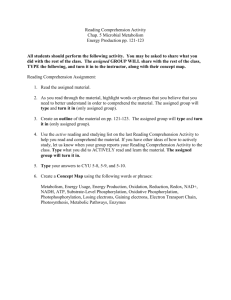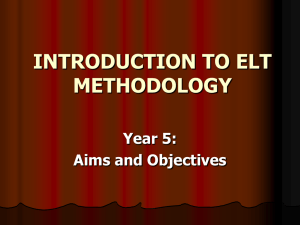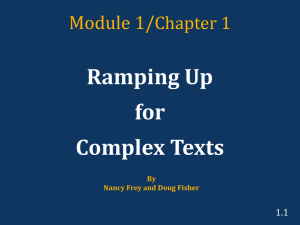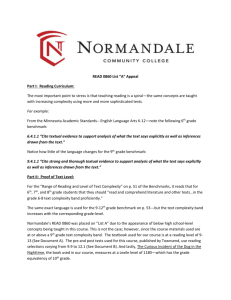Unit 6
advertisement
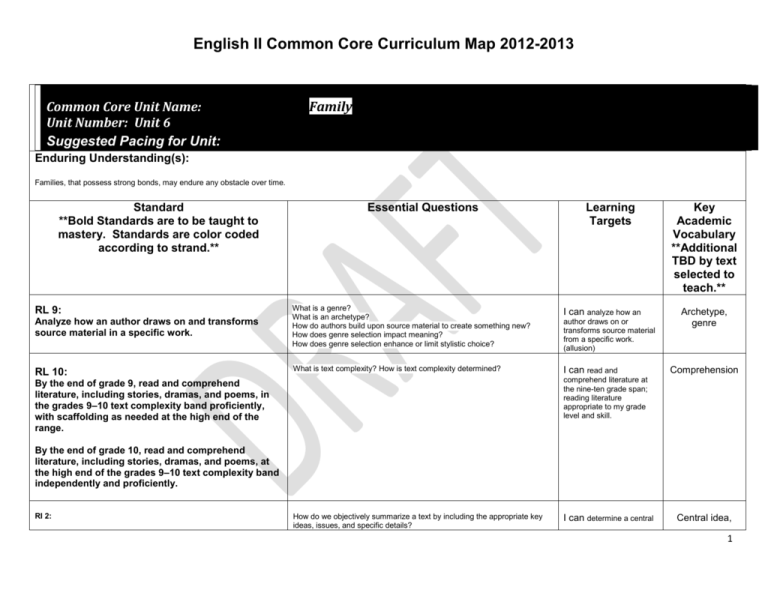
English II Common Core Curriculum Map 2012-2013 Common Core Unit Name: Unit Number: Unit 6 Suggested Pacing for Unit: Family Enduring Understanding(s): Families, that possess strong bonds, may endure any obstacle over time. Standard **Bold Standards are to be taught to mastery. Standards are color coded according to strand.** Essential Questions Learning Targets What is a genre? What is an archetype? How do authors build upon source material to create something new? How does genre selection impact meaning? How does genre selection enhance or limit stylistic choice? I can analyze how an Analyze how an author draws on and transforms source material in a specific work. RL 10: What is text complexity? How is text complexity determined? I can read and RL 9: author draws on or transforms source material from a specific work. (allusion) Key Academic Vocabulary **Additional TBD by text selected to teach.** Archetype, genre Comprehension comprehend literature at the nine-ten grade span; reading literature appropriate to my grade level and skill. By the end of grade 9, read and comprehend literature, including stories, dramas, and poems, in the grades 9–10 text complexity band proficiently, with scaffolding as needed at the high end of the range. By the end of grade 10, read and comprehend literature, including stories, dramas, and poems, at the high end of the grades 9–10 text complexity band independently and proficiently. RI 2: How do we objectively summarize a text by including the appropriate key ideas, issues, and specific details? I can determine a central Central idea, 1 English II Common Core Curriculum Map 2012-2013 Determine a central idea of a text and analyze its development over the course of the text, including how it emerges and is shaped and refined by specific details; provide an objective summary of the text. How do we analyze ideas, issues, rhetoric devices, and specific details in a text that develop the central idea and/or claim? How do we participate actively and appropriately in discussions about informational text? idea in a text, and analyze how its development and how it emerges and is shaped through details. analyze, objective summary I can give an objective summary of the text. RI 7: Analyze various accounts of a subject told in different mediums (e.g., a person’s life story in both print and multimedia), determining which details are emphasized in each account. RI 10: By the end of grade 9, read and comprehend literary nonfiction in the grades 9–10 text complexity band proficiently, with scaffolding as needed at the high end of the range. By the end of grade 10, read and comprehend literary nonfiction at the high end of the grades 9–10 text complexity band independently and proficiently. W2: Write informative/explanatory texts to examine and convey complex ideas, concepts, and information clearly and accurately through the effective selection, organization, and analysis of content. a. Introduce a topic; organize complex ideas, concepts, and information to make important connections and distinctions; include formatting (e.g., headings), graphics (e.g., figures, tables), and multimedia when useful to aiding comprehension. b. Develop the topic with well-chosen, relevant, and sufficient facts, extended definitions, concrete How do we demonstrate the behaviors of a strategic reader, listener, or viewer of print, non-print, and digital text? How do we analyze print, non-print, and digital text for relevant details that are emphasized in an informational text and that contribute to meaning? How do we compare, contrast, draw conclusions, and connect significant details and ideas between two different mediums? How do we participate actively and appropriately in discussions about informational text? I can analyze accounts of How do we demonstrate understanding of a wide range of sufficiently complex literary texts? How do we comprehend texts of steadily increasing complexity, with scaffolding if needed? How do we set personal reading goals to self select and explore texts of different disciplines and increasing complexity? How do we participate actively and appropriately in discussions about informational text? I can read and How do you organize ideas, concepts, and information to build evidence? How do you use multimedia sources to aid comprehension? How do you develop your topic thoroughly giving appropriate examples/supporting details (including definitions, quotations, facts)? Do your concepts and ideas have clear relationships? Do you use appropriate diction, syntax, and other techniques (e.g. metaphor, simile, and analogy)? How do you maintain formal style throughout your writing? How do you maintain objectivity? How does your conclusion articulate and support the significance of your topic? I can write an informative the same subject told in a different medium, determining which aspects are emphasized in which medium. comprehend informational text appropriate for the grade span. piece, which examines and conveys complex ideas/information through effective selection, organization, and analysis of content; where I, a - introduce a topic, organize complex ideas to make connections, include formatting, graphics, and multimedia when useful, b - use well-chosen and relevant facts, definitions, Strategic, digital text, non-print text, relevant Scaffold, informational text, active participation, discipline Multimedia, diction, syntax, style, articulate 2 English II Common Core Curriculum Map 2012-2013 details, and quotations, or other examples to develop the topic, c - use appropriate, varied transitions to create cohesion and clarify relationships, d - use precise language and vocabulary to manage the complexity of the topic, e - establish and maintain a formal style and objective tone, and f - provide a concluding statement or section that supports the information presented. details, quotations, or other information and examples appropriate to the audience’s knowledge of the topic. c. Use appropriate and varied transitions to link the major sections of the text, create cohesion, and clarify the relationships among complex ideas and concepts. d. Use precise language and domain-specific vocabulary to manage the complexity of the topic. e. Establish and maintain a formal style and objective tone while attending to the norms and conventions of the discipline in which they are writing. f. Provide a concluding statement or section that follows from and supports the information or explanation presented (e.g., articulating implications or the significance of the topic). W 6: Use technology, including the Internet, to produce, publish, and update individual or shared writing products, taking advantage of technology’s capacity to link to other information and to display information flexibly and dynamically. L 6: What are the different ways to publish a work? How do you use technology to link and display information? I can use technology to How do you built a college and/or career ready vocabulary? I can use vocabulary Acquire and use accurately general academic and domain-specific words and phrases, sufficient for reading, writing, speaking, and listening at the college and career readiness level; demonstrate independence in gathering vocabulary knowledge when considering a word or phrase important to comprehension or expression. SL 5: Make strategic use of digital media (e.g., textual, graphical, audio, visual, and interactive elements) in produce, publish, and update my own work, and shared writing projects. appropriate to ninth and tenth grade topics. I can use resources to gather word knowledge when needing a word important for comprehension and/or expression. What forms of digital media are available? How can digital media enhance the presentation of findings, reasoning, and evidence? Which multimedia/visuals work best for which contexts? I can strategically use digital media to enhance understandings and add interest. Publish, capacity Comprehension, expression, college/career ready vocabulary Reasoning, evidence, strategic, 3 English II Common Core Curriculum Map 2012-2013 presentations to enhance understanding of findings, reasoning, and evidence and to add interest. Suggested Resources for Unit interactive Location of these resources **Always check with department chair for availability of class sets. Always check table of contents of resource textbook for availability of suggested selections. Julius Ceasar (drama) “Tuesday Siesta” (short story) Antigone (drama) “The Prince” (political treatise) “The Book of Ruth” (sacred text) “Madly Singing in the Mountains” (poem) “The Sky Is Just Beyond the Roof” (poem) “The Piece of String” (short story) “The Myth of Sisyphus” (essay) from “Writing as an Act of Hope” (essay) “Ocean of Words” (short story) Holt Elements of Literature: World Literature http://www.dpi.state.nc.us/docs/acre/standards/common-coretools/exemplar/ela.pdf 4
